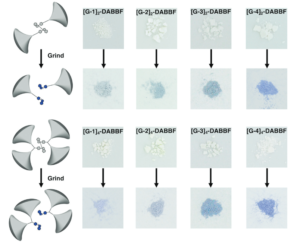We all know what happens when materials take too much mechanical stress – they eventually break.
What if you could easily tell when something like a support was close to its maximum stress, before it undergoes a catastrophic event, just by looking at it? One option is to incorporate a mechanochromic polymer, a polymer that changes color when under sufficient mechanical stress, to provide a visual indicator that a material has reached a specific stress threshold. The polymers don’t need to be entirely composed of mechanochromically active moieties to exhibit useful properties; many studies have focused on a single active mechanophore at the center of a large polymer chain. In fact, the mechanical force is greatest at the center of a chain and is directly proportional to the length of the chains. This holds for polymers in solution but hasn’t been extensively studied in the types of bulk systems useful for applications.
Recently, researchers in Japan set out to characterize the effects of chain length and branching on mechanochromic dendrimers, polymers with monodisperse and regularly branched globular structures. Showing that dendrimers exhibit mechanochromism is already a novel result, but their well-defined nature allowed the researchers to draw correlations between structure and bulk responsiveness. They employed diarylbibenzylfuranone (DABBF) as the mechanochromic moiety since it generates arylbenzofuranone (ABF) radicals, which are blue, air-stable, and electron paramagnetic resonance spectroscopy (EPR) active, when exposed to mechanical force (Figure 1).
These characteristics allow for straightforward qualitative and quantitative analysis. The team coupled the DABBF moiety with two series of dendrimers, with increasing generations having larger and more highly branched monomer units, to create a range of molecular weights and degrees of branching for study. The dendrimers showed a color change from white to blue (Figure 2) when ground in a ball mill, which was used to ensure the reproducibility of the force applied to all samples.

Figure 2. Photographs of the first (top) and second (bottom) mechanochromic dendrimers before and after grinding, showing the color change associated with the generation of ABF radicals.
EPR measurements confirmed the presence of the ABF radicals in the samples after milling, demonstrating that the color change is due to the cleavage of the DABBF. The integrated EPR spectra were used to quantitatively determine the percentage of DABBF moieties that dissociated. The responsiveness of the dendrimers increased exponentially with increasing generation and branching. However, the primary factor governing ABF generation was found to be molecular weight. Two dendrimers with different levels of chain entanglement, but similar molecular weights, exhibited comparable cleavage ratios. The question then became does molecular weight increase the transfer efficiency of force to the DABBF or does the increased steric bulk make it harder for the ABF radicals to recombine? To probe the kinetics of this process, the researchers varied the grinding time and saw that within 5 minutes all the highly branched samples reached their maximum dissociation level. Additionally, monitoring the ABF recombination showed that even after 6 hours approximately 95% of the radicals remained dissociated in all 3rd and 4th generation dendrimers. These data suggest that the enhancement in responsiveness can be attributed to better force transmission to the DABBF.
This work shows mechanoresponsiveness in a range of dendrimers with varying degrees of branching and rigidity. Not only did they demonstrate novel activity, but the researchers also probed the mechanism of the enhanced activity with increasing molecular weight. This initial study opens avenues to explore polymer rigidity, surface functionality, and other dendrimer features to design new, functional materials.
To find out more, please read:
Takuma Watabe, Kuniaki Ishizuki, Daisuke Aoki, and Hideyuki Otsuka
Chem. Commun., 2019, 55, 6831-6834.
About the blogger:
 Beth Mundy is a PhD candidate in chemistry in the Cossairt lab at the University of Washington in Seattle, Washington. Her research focuses on developing new and better ways to synthesize nanomaterials for energy applications. She is often spotted knitting in seminars or with her nose in a good book. You can find her on Twitter at @BethMundySci.
Beth Mundy is a PhD candidate in chemistry in the Cossairt lab at the University of Washington in Seattle, Washington. Her research focuses on developing new and better ways to synthesize nanomaterials for energy applications. She is often spotted knitting in seminars or with her nose in a good book. You can find her on Twitter at @BethMundySci.











